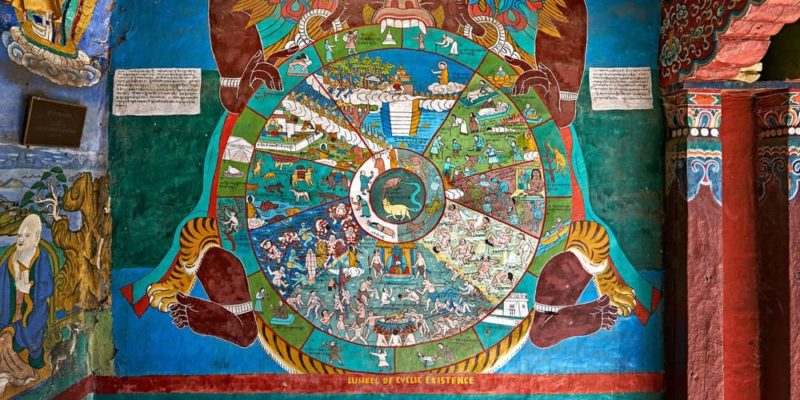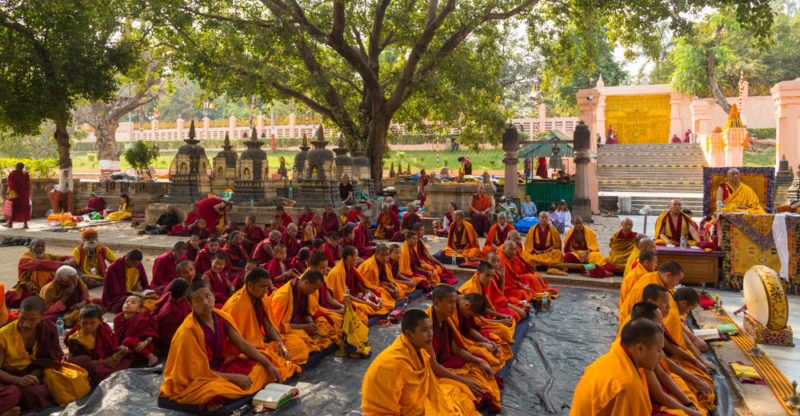We explain what Buddhism is and how this religion originated. Also, what are its characteristics, philosophical principles, and symbols.
What is Buddhism?
Buddhism is both a religion and a non-theistic philosophical and spiritual doctrine, that is, it does not pose the existence of a specific god or creator. It belongs to the dharmic family of beliefs from India. As a philosophy, it points to asceticism and contemplation, drawing on the ancient belief systems of the Vedic religions.
In its bosom, there are a set of traditions, beliefs, rites, and spiritual practices that vary according to the branch of Buddhism to which it refers. They all have in common the teachings of Siddharta Gautama, an ascetic and spiritual teacher better known as Buddha.
As a doctrine, Buddhism does not focus on the reverence or devotion of any god, but on the spiritual development of each individual. It is achieved through deep contemplation of life and the practice of detachment, meditation, and the transcendence of worldly pleasures and desires.
Origin of Buddhism
Buddhism emerged in northeast India between the 6th and 4th centuries BC. C.
It was a time of great social change and intense religious activities.
The prevailing Brahmin religion (belonging to the higher castes) was in a moment of crisis.
With a climate conducive to cultural transformations, many scholars tended to reinterpret the Vedic texts, while others experimented with new forms of mysticism.
Towards the III century a. C. the teachings of the teacher and founder of Buddhism, known as Buddha, had rapidly expanded to become the majority religion. Finally, the Indian Emperor A?oka proclaimed it the official religion of his government.
History of Buddhism

Buddhism reigned in India until the 7th century AD. C. At that time it suffered a dramatic decrease in the number of practitioners due to the invasions of the Alcon Huns and the confrontation with other Vedic religions, such as Hinduism.
However, its importance in neighboring nations was increasing. As a consequence, by the thirteenth century, it had practically disappeared from India but had spread to central and southeast Asia, enjoying a following in China, Korea, and Japan.
In addition to being one of the pillars of Asian spiritual culture, it also became popular in the West from the 20th century on. The universalistic nature of his beliefs has allowed him to adapt to diverse cultures, languages, and societies. Thus it became one of the largest religions in the world.
Who was your founder of Buddhism?
The founder of Buddhism was Siddharta Gautama, also known as Gautama Buddha, Sakyamuni ("the sage of the Sakia"), or simply as Buddha. However, "Buddha" (from Sanskrit Buddha ) is a Vedic spiritual title, which roughly means "the awakened one" or "the enlightened one."
This means that the same name is given to those who have achieved true spiritual enlightenment. In that sense, the founder of Buddhism was not the first Buddha, much less the only one, but he was perhaps the most important ascetic and sage of the time.
Siddharta Gautama was born in Kapilavatthu, in the Himalayan mountain range, in the former Sakia republic. It is said that it was there between 563 and 483 BC. C., approximately, although there are discrepancies regarding his date of birth.
Thanks to his pilgrimage, the foundations of Buddhism reached the entire region. Siddhartha taught a middle way between hedonism and asceticism. His teachings were initially transmitted orally until the first texts appeared four centuries after his death.
Much of what is known about Siddartha's life comes from stories and legends. It is argued that he was noble by birth but renounced the palace and his life of luxury at the age of 29, convinced that he had found the inner truth of existence.
Philosophical principles of Buddhism

Buddhism as a doctrine can vary enormously depending on the branch, but usually, it contemplates the same philosophical principles, which can be summarized as:
- The three brands or the three realities. According to Buddhism, the nature of the world of the perceived, that is, of the world that the senses cast, is defined by three fundamental characteristics: Anitya (impermanence), An?tman (insubstantiality), and Du?kha (suffering, discontent).
- The Karma. Any intentional action, according to Buddhism, creates one or more effects that will be perceived later, when the circumstances are correct. Karma can be "good" or "bad", depending on the nature of the action, and it can manifest according to four types:
- Dark karma with dark result
- Brilliant Karma with Brilliant Result
- Dark and bright karma with a dark and bright result
- Karma is neither dark nor bright with a result neither dark nor bright
Thus karma occurs in a variety of complex motivations. Karma determines the foreseeable destiny of people based on four types:
-
- Who does evil and goes to hell, a state of degeneration or a lower rebirth.
- Who does evil and goes to heaven, happy state, or higher rebirth.
- Who does good and goes to heaven, happy state, or higher rebirth.
- Who does good and goes to hell, a state of degeneration, or a lower rebirth.
It should be noted that heaven and hell do not have to do with destinies after death, but rather states of the spirit.
- Samsara. Western religions have a conception of linear time and at the end of life, there would be a reward or a punishment. Rather, Buddhism envisions a circular time, eternally repeating itself in a cycle of birth, suffering, and reincarnation, known as Samsara.
- Nirvana. The state of spiritual enlightenment to which every Buddhist aspires. It is explained in mystical terms as the elevation above the eternal wheel of birth, suffering, death, and reincarnation.
Buddhism beliefs

The beliefs of Buddhism can be expressed through the so-called Four Noble Truths, expressed by Buddha in his first discourse (Sutra) after enlightenment:
- Life includes du?kha. Life is imperfect, and to exist is to live with dissatisfaction and suffering, which are universal. This is the starting point of all Buddhist practice.
- The origin of suffering is t????. The suffering of life originates from desire, longing, the craving caused by the senses or sensual pleasure, and the belief that some action will lead to the satisfaction of said desire, but this is an illusion because the “ I ”is an illusion of the mind.
- There is the cessation of du?kha. That is, suffering ceases with the abandonment of desires, which is achieved by facing life as it really is, and understanding the causes of our own suffering as something that nests in us.
- There is a method to extinguish suffering. Buddhism calls this path the "Noble Eightfold Path." It consists of the search for a middle ground, avoiding excessive satisfaction and excessive mortifications, through ethical conduct, meditation, mindfulness, and awareness of the present continuously.
Buddhism symbols

The use of certain symbols in the practice or teaching of Buddhism is common, such as:
- The wheel of Dharma. Known as dharma chakra, it represents the Noble Eightfold Path that Buddha taught his disciples.
- The endless knot. Called Srivatsan in Sanskrit and used in Tibetan Buddhism, it symbolizes the eternal wisdom of the Buddha, as it has neither beginning nor end.
- The Bodhi tree. Se trata del árbol en el que Buda se sentó a meditar en Bodh Gaya, hasta alcanzar la iluminación.
- The lotus flower. Symbol of mental purity that floats above the mire of everyday life.
Branches of Buddhism
Buddhism has three different branches:
- Therevada. The "doctrine of the elders" is the most conservative aspect regarding dharma (doctrine) and Vinaya (monastic discipline). It developed early in Sri Lanka and then spread to the rest of Asia.
- Mahayana. Practiced in China, Japan, Tibet, Korea, Vietnam, and Taiwan, it began in the 1st century AD. C. and understands the teachings of Buddha more as a method than as a doctrine.
- Vajrayana. Born of the Mahayana, it differs from it in the adoption of "skillful methods" or pay, such as mantras, tantras, mandalas, and other forms of visualization.
Buddhist texts

Buddhism was originally transmitted orally, even for centuries after the Buddha's death. The first texts on his teachings are much later and come from Sri Lanka.
There is no common or hegemonic corpus of Buddhist texts since each tradition chooses, reads, and orders them differently. However, they are usually a combination of Pali Buddhist and Sanskrit texts from India, such as the Pali Canon, the "standard" collection of Buddha's teachings.
Sacred places of Buddhism

- Lumpini ( Nepal ). Buddha's birthplace.
- Bodh Gaya (India). Here he reached enlightenment.
- Sarnath (India). Where he gave his first sermon.
- Kushinagar (India). Place of death.
Followers of Buddhism in the world
They are estimated at 400 to 1 billion people worldwide. The country with the largest number of followers of Buddhism today is China.
The above content published at Collaborative Research Group is for informational and educational purposes only and has been developed by referring to reliable sources and recommendations from technology experts. We do not have any contact with official entities nor do we intend to replace the information that they emit.
Anas is an editor of a prestigious publishing company in the United States. She studied Mathematics in Arizona. Anas is also a teacher and one of her long-term goals is to build an institution that offers free education to everyone who are financially not stable. .
Leave a reply
Your email address will not be published. Required fields are marked *Recent post

Sport: What Is It, Types, Risks, Features, Characteristics and Examples

Dogs: Emergence, Features, Characteristics, Feeding and Breeds

Story: Definition, Elements, Structure, Features and Characteristics

